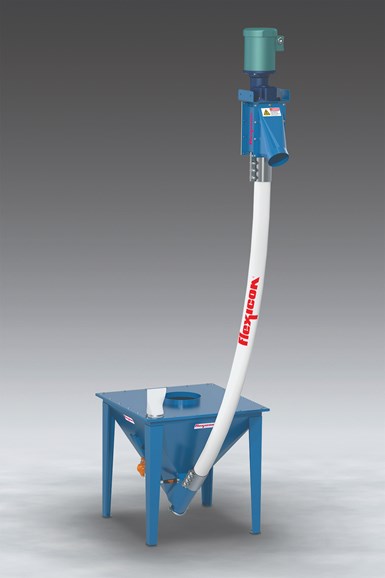Flexible Screw Conveyor Resists Abrasion
Features steel conveyor tube, heavy-duty flexible screw, and heavy-gauge floor hopper and discharge housing.
Flexicon has introduced a wear-resistant flexible screw conveyor with carbon steel conveyor tube, heavy-duty flexible screw, and heavy-gauge floor hopper and discharge housing, capable of moving abrasive materials.
The screw is available in lengths up to 40 ft in round, square, flat or beveled profiles to optimize conveying efficiency for each application. The 4-1/2 in. conveyor tube is available curved to vertical, to horizontal or any angle.
The screw is the only moving part contacting material. Its lower end has no bearing, while its upper end is driven beyond the material discharge point, preventing material contact with the upper seal or bearing. This configuration facilitates simple maintenance in harsh environments since the single moving component can be quickly replaced if necessary.
As it rotates, the screw self-centers, providing ample space between itself and the tube wall to minimize or eliminate grinding. The gentle rolling action imparted by the screw prevents the separation of blends, while the enclosed conveyor tube prevents product and plant contamination.

Supplied as standard with a durable industrial coating, the unit is available with an optional UL-listed start-stop control panel and a range of flow-promotion devices.
Related Content
-
Processors: Gear Up to Handle More Regrind
Plastics auxiliary and primary processing equipment was optimized for running pellets; here’s how you can adjust to the bulk density differences of flake and regrind in drying, conveying, mixing, feeding and processing.
-
AI Comes to Resin Conveying with Conair Technology
This patented technology automatically detects source-to-destination conditions and autonomously adjusts the conveying system in real-time to move material under optimal conditions.
-
How to Effectively Reduce Costs with Smart Auxiliaries Technology
As drying, blending and conveying technologies grow more sophisticated, they offer processors great opportunities to reduce cost through better energy efficiency, smaller equipment footprints, reduced scrap and quicker changeovers. Increased throughput and better utilization of primary processing equipment and manpower are the results.






